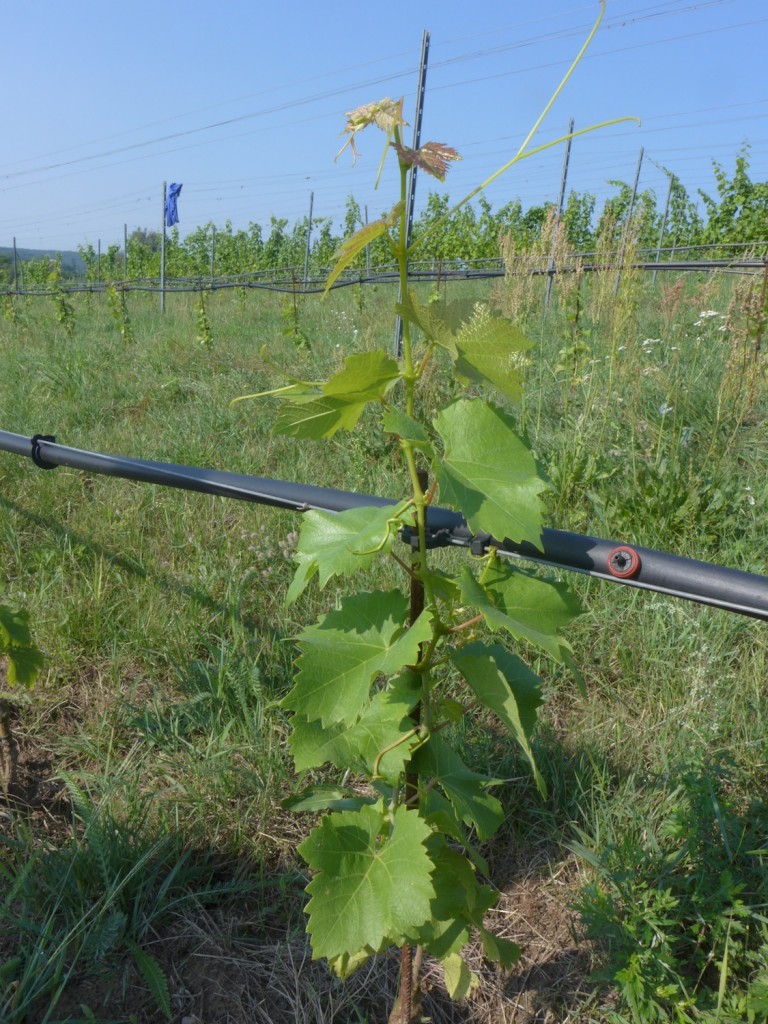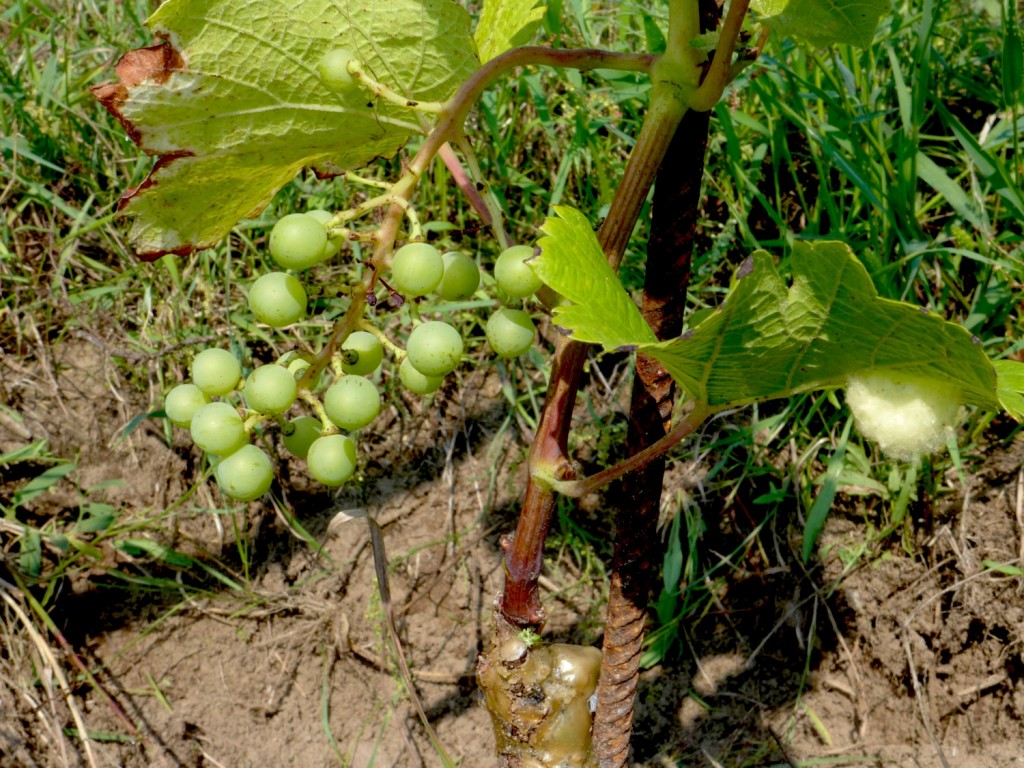 This photograph taken early this morning a short train ride/drive outside Berlin in a southwesterly direction in the state of Brandenburg shows why I’m in such high spirits today. It shows one of the almost one thousand Pinotin vines I planted on May 3rd with the help of a motley crew of winegrower friends (thank you team, once again!) and as you can see it grew really the last three months and one week. In this parcel (rows 48 thru 57 on the eastern side of the hillside) almost all the vines look this, and in the other parcel we planted (rows 3 thru 6 plus rows 8 & 9 on the western side) most of the vines look rather similar. There only the vines in the two shortest rows with the poorest, driest soil of the entire south-facing hill look a bit weak and stressed. This rather surprising progress during my long absence in the USA means that there are at least 850, and perhaps as many as 900 Pinotin, vines on the Töplitzer Berg (where wine growing was first recorded back in 1360!) that are health enough – with a bit of luck – to give a small crop in 2015. My guess is that we’ll then get enough wine to fill a barrique and fill the first 300 bottles during the winter of 2016/17!
This photograph taken early this morning a short train ride/drive outside Berlin in a southwesterly direction in the state of Brandenburg shows why I’m in such high spirits today. It shows one of the almost one thousand Pinotin vines I planted on May 3rd with the help of a motley crew of winegrower friends (thank you team, once again!) and as you can see it grew really the last three months and one week. In this parcel (rows 48 thru 57 on the eastern side of the hillside) almost all the vines look this, and in the other parcel we planted (rows 3 thru 6 plus rows 8 & 9 on the western side) most of the vines look rather similar. There only the vines in the two shortest rows with the poorest, driest soil of the entire south-facing hill look a bit weak and stressed. This rather surprising progress during my long absence in the USA means that there are at least 850, and perhaps as many as 900 Pinotin, vines on the Töplitzer Berg (where wine growing was first recorded back in 1360!) that are health enough – with a bit of luck – to give a small crop in 2015. My guess is that we’ll then get enough wine to fill a barrique and fill the first 300 bottles during the winter of 2016/17!
That would mean that the plan which caused so many experienced people in the German wine industry to raise eyebrows, laugh or call me a fool was not so stupid after all. I say this not because I want to prove anything, or to pat myself on the back, but because I hope the success of this experiment will encourage others to take a similar path, hopefully with greater success. Anyone doubting that the Pinotin vine, developed by the Swiss vine breeder Valentin Blattner together with the Freytag vine nursery in the Pfalz/Germany, could successfully carry a crop grapes in the Greater Berlin Area should study the photograph below. I took it this morning in Töplitz too!
 Of course, Pinotin has nothing to do with Riesling, is a red wine grape, but I feel that it makes more sense here and remain highly skeptical about Riesling in the Greater Berlin Area. So far I had just one good example from this new frontier of German winegrowing that was convincing, and it was (a 2006) from a very small plot in the Prenzlauer Berg district of the city tended by hobbyists. As the Germans rightly say, one rose doesn’t make a summer. This year the summer in the Greater Berlin Area was much better than last year, but in spite of the mediocre growing conditions the dry 2012 Grauburgunder (Pinot Gris) from the Klosterhof Töplitz estate (where my Pinotin project resides) is a very attractive wine with a ripe melon aroma, 12.5% natural alcohol and about 0.8% natural sweetness (in retrospect less would have been better). I have to admit I was skeptical about Pinot Gris in the Greater Berlin Area until I tasted that wine, so who knows. Maybe you just need to grow Riesling the right way here around 52° 30′ (look how far up the map of Canada that is!). The next years will tell. Stay tuned to this station where the results of many winegrowing experiments in Berlin and environs will be publicized.
Of course, Pinotin has nothing to do with Riesling, is a red wine grape, but I feel that it makes more sense here and remain highly skeptical about Riesling in the Greater Berlin Area. So far I had just one good example from this new frontier of German winegrowing that was convincing, and it was (a 2006) from a very small plot in the Prenzlauer Berg district of the city tended by hobbyists. As the Germans rightly say, one rose doesn’t make a summer. This year the summer in the Greater Berlin Area was much better than last year, but in spite of the mediocre growing conditions the dry 2012 Grauburgunder (Pinot Gris) from the Klosterhof Töplitz estate (where my Pinotin project resides) is a very attractive wine with a ripe melon aroma, 12.5% natural alcohol and about 0.8% natural sweetness (in retrospect less would have been better). I have to admit I was skeptical about Pinot Gris in the Greater Berlin Area until I tasted that wine, so who knows. Maybe you just need to grow Riesling the right way here around 52° 30′ (look how far up the map of Canada that is!). The next years will tell. Stay tuned to this station where the results of many winegrowing experiments in Berlin and environs will be publicized.

![120114_riesling_global_RZ [1600x1200]](http://www.stuartpigott.de/wp-content/uploads/2013/08/120114_riesling_global_RZ-1600x12003.jpg)